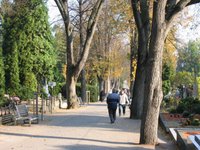Dušičky
 I mentioned Dušičky yesterday. What are these “little souls” celebrations? Commonly celebrated on the second of November, they coincide with the Christian celebrations of All Saints Day (1 Nov.) and the Day of the Dead (2 Nov.). Christian belief traditionally marks the Day of the Dead as a time in which to express gratitude and respect for ancestors. According to folk beliefs, as noted in Vlastimil Vondruška’s book Církevní rok a lidové obyčeje (The ecclesiastical year and folk customs; published by Dona), the spirits of the dead are released from purgatory on the eve of Dušičky. This is the only day of the year on which the spirits are permitted to rest. Often lamps were burned with butter for oil (butter is thought to sooth burns, even those inflicted by unearthly fires I guess), or families drank cold milk because milk was thought to aid in cooling scorched souls. Today families often make a trip to the cemetery in order to light a candle on the graves of the departed. There were certainly more people in the cemetery than I have ever seen there at one time.
I mentioned Dušičky yesterday. What are these “little souls” celebrations? Commonly celebrated on the second of November, they coincide with the Christian celebrations of All Saints Day (1 Nov.) and the Day of the Dead (2 Nov.). Christian belief traditionally marks the Day of the Dead as a time in which to express gratitude and respect for ancestors. According to folk beliefs, as noted in Vlastimil Vondruška’s book Církevní rok a lidové obyčeje (The ecclesiastical year and folk customs; published by Dona), the spirits of the dead are released from purgatory on the eve of Dušičky. This is the only day of the year on which the spirits are permitted to rest. Often lamps were burned with butter for oil (butter is thought to sooth burns, even those inflicted by unearthly fires I guess), or families drank cold milk because milk was thought to aid in cooling scorched souls. Today families often make a trip to the cemetery in order to light a candle on the graves of the departed. There were certainly more people in the cemetery than I have ever seen there at one time.Not having any family buried in Brno, I lit a candle on the grave of František Sušil, my favorite nineteenth-century folk-song collector. Many famous personalities had similar flower arrangements placed on their graves, and graves of national heroes were draped with the Czech trikolora (tricolor, i.e., blue, red, and white). The poem on Sušil’s grave reads (roughly) as follows:
Two beauties hold sway over my sleeping spirit at this stone,
One earthly, the other sent from heaven above.
The Church and the homeland, by sisterly love entwined in my bosom,
My heart holds them both: each has but a half yet at the same time the whole.

 A graduate student in music and anthropology writing a dissertation about music in Moravia, the eastern third of the Czech Republic. At some point, the Czech Republic's "second city" (that would be Brno) captured my attention, and I've since been blogging about events, arts, music, and other stuff—basically whatever interests me in and around the cityscape. I'm not living in Brno now, but I keep up with the cultural pulse from afar as best I can.
A graduate student in music and anthropology writing a dissertation about music in Moravia, the eastern third of the Czech Republic. At some point, the Czech Republic's "second city" (that would be Brno) captured my attention, and I've since been blogging about events, arts, music, and other stuff—basically whatever interests me in and around the cityscape. I'm not living in Brno now, but I keep up with the cultural pulse from afar as best I can.


Comments:
» Post a Comment